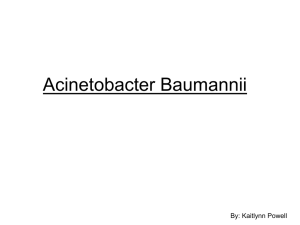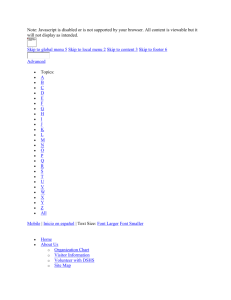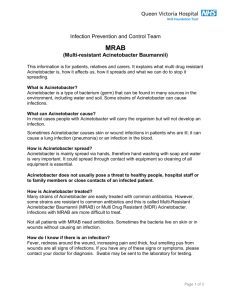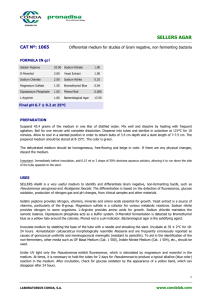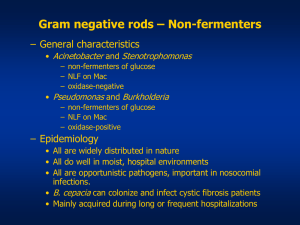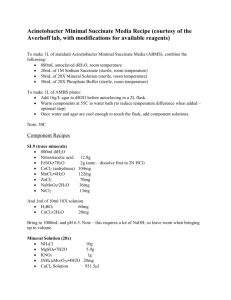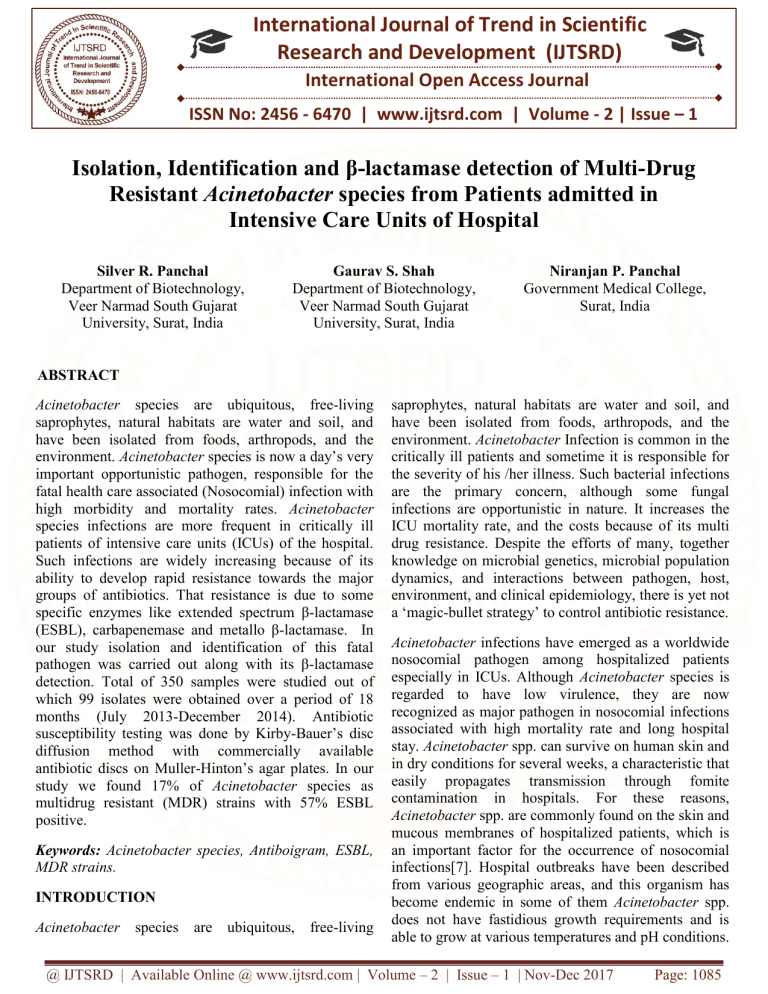
International Journal of Trend in Scientific
Research and Development (IJTSRD)
International Open Access Journal
ISSN No: 2456 - 6470 | www.ijtsrd.com | Volume - 2 | Issue – 1
Isolation, Identification and β-lactamase detection of Multi-Drug
Resistant Acinetobacter species from Patients admitted in
Intensive Care Units of Hospital
Silver R. Panchal
Department of Biotechnology,
Veer Narmad South Gujarat
University, Surat, India
Gaurav S. Shah
Department of Biotechnology,
Veer Narmad South Gujarat
University, Surat, India
Niranjan P. Panchal
Government Medical College,
Surat, India
ABSTRACT
Acinetobacter species are ubiquitous, free-living
saprophytes, natural habitats are water and soil, and
have been isolated from foods, arthropods, and the
environment. Acinetobacter species is now a day’s very
important opportunistic pathogen, responsible for the
fatal health care associated (Nosocomial) infection with
high morbidity and mortality rates. Acinetobacter
species infections are more frequent in critically ill
patients of intensive care units (ICUs) of the hospital.
Such infections are widely increasing because of its
ability to develop rapid resistance towards the major
groups of antibiotics. That resistance is due to some
specific enzymes like extended spectrum β-lactamase
(ESBL), carbapenemase and metallo β-lactamase. In
our study isolation and identification of this fatal
pathogen was carried out along with its β-lactamase
detection. Total of 350 samples were studied out of
which 99 isolates were obtained over a period of 18
months (July 2013-December 2014). Antibiotic
susceptibility testing was done by Kirby-Bauer’s disc
diffusion method with commercially available
antibiotic discs on Muller-Hinton’s agar plates. In our
study we found 17% of Acinetobacter species as
multidrug resistant (MDR) strains with 57% ESBL
positive.
Keywords: Acinetobacter species, Antiboigram, ESBL,
MDR strains.
INTRODUCTION
Acinetobacter
species
are
ubiquitous,
free-living
saprophytes, natural habitats are water and soil, and
have been isolated from foods, arthropods, and the
environment. Acinetobacter Infection is common in the
critically ill patients and sometime it is responsible for
the severity of his /her illness. Such bacterial infections
are the primary concern, although some fungal
infections are opportunistic in nature. It increases the
ICU mortality rate, and the costs because of its multi
drug resistance. Despite the efforts of many, together
knowledge on microbial genetics, microbial population
dynamics, and interactions between pathogen, host,
environment, and clinical epidemiology, there is yet not
a ‘magic-bullet strategy’ to control antibiotic resistance.
Acinetobacter infections have emerged as a worldwide
nosocomial pathogen among hospitalized patients
especially in ICUs. Although Acinetobacter species is
regarded to have low virulence, they are now
recognized as major pathogen in nosocomial infections
associated with high mortality rate and long hospital
stay. Acinetobacter spp. can survive on human skin and
in dry conditions for several weeks, a characteristic that
easily propagates transmission through fomite
contamination in hospitals. For these reasons,
Acinetobacter spp. are commonly found on the skin and
mucous membranes of hospitalized patients, which is
an important factor for the occurrence of nosocomial
infections[7]. Hospital outbreaks have been described
from various geographic areas, and this organism has
become endemic in some of them Acinetobacter spp.
does not have fastidious growth requirements and is
able to grow at various temperatures and pH conditions.
@ IJTSRD | Available Online @ www.ijtsrd.com | Volume – 2 | Issue – 1 | Nov-Dec 2017
Page: 1085
International Journal of Trend in Scientific Research and Development (IJTSRD) ISSN: 2456-6470
Acinetobacter spp. are often multidrug resistant and
associated with life-threatening infections especially in
patients with factors that impair normal host resistance.
One of the important causes of nosocomial infections
are Acinetobacter species[3] with Acinetobacter
baumannii being recognized as the most common
clinical
isolate
from
nosocomial
infections.
Acinetobacter baumannii has epidemic potential and is
being identified as a major cause of outbreak or
sporadic cases with high mortality rates accounting for
about 80% of reported infection worldwide [5].
Acinetobacter infections have been reported for almost
all organ systems. It is usually an opportunistic
pathogen as evidenced by the fact that 14% to 16% of
infections are mixed infection [4]. Acinetobacter
species is now recognized to be the species of great
clinical importance being capable of causing life
threatening infection including pneumonia, septicemia,
wound sepsis, urinary tract infection, endocarditis and
meningitis. It was found in the 1990 to 1992 National
Nosocomial Infection Surveillance (NNIS) data that 2%
of blood stream infections and 4% of nosocomial
pneumonia cases were due to Acinetobacter. Also it is
currently the most common isolate from gram negative
sepsis in immunocompromised patients posing risk for
high mortality. The organism prefers moist
environment, therefore, its colonization among
damaged tissues is common [8].
Antimicrobial resistance among Acinetobacter species
has increased substantially in the past decade [13]. The
capacity of Acinetobacter species for extensive
antimicrobial resistance may be due in part to the
organism's relatively impermeable outer membrane and
its environmental exposure to a large reservoir of
resistance genes [6]. Mechanisms of its resistance are
impressive and rival those of other non-fermentative
Gram-negative pathogens [14].
Materials and Methodology
Isolation and identification of Acinetobacter species
was carried out at the Department of Microbiology,
Surat Municipal Institute of Medical Education and
Research, (SMIMER) a tertiary care public hospital in
Surat. The total sample size consisted of 350
consecutive clinical specimens (blood, swab,
endotracheal, pus, sputum, urine and fluid) received
from different intensive care units: Neonatal ICU
(NICU), Pediatric ICU (PICU), Surgical ICU (SICU),
Intensive Cardiac Care Unit (ICCU) and Medical ICU
(MICU) of the hospital. Samples of the patients
admitted in the ICUs during July 2013 to December,
2014 were included in our study. In our study patients
admitted in any of the five ICUs of the hospital during
the study period, who were clinically suspected of
having acquired any bacterial infection after 48 h of
admission to the ICUs, were included. Patients showing
clinical signs of infection on or prior to admission or
transfer to the ICUs were not included [1].
Collection of samples from patients suspected for
bacterial infections was done using sterile containers.
Different types of samples were collected, blood
samples were collected using sterile hypodermic
syringe with needle and transferred to sterile blood
culture bottles having Brain Heart Infusion (BHI)
medium, swab samples were collected using sterile
swab sticks available commercially, pus, body fluids,
sputum, and urine samples were collected using sterile
containers. Only bacterial infections were studied in
detail. Samples were then subjected to the identification
and antibiotic sensitivity with ESBL detection [2].
All the clinical samples were initially subjected to
direct microscopy (e.g. gram staining, motility and wet
film examination). According to the findings of the
direct microscopy (wherever applicable), presumptive
identification of the bacteria was done along with the
selection of the culture media.
All the clinical specimens were inoculated initially on
non-selective media as Nutrient agar, Blood agar, and
Mac-Conkey agar. The selection of the selective media
was determined by the findings of the direct
microscopy. The inoculated culture plates were
examined for growth after an incubation period of 2448 h at 37°C. For the blood samples, blood cultures
were done using brain heart infusion (BHI) broth as a
primary culture medium. Grams staining and first blind
subcultures were done by using Nutrient agar plate,
Blood agar plate and Mac-Conkey’s agar plate after 24
h of inoculation. In case of no growth, the blood culture
bottles were further incubated for five day at 37°C after
which, final subcultures were done. All the specimens
were further analyzed using various biochemical tests
according to the morphology observed.
The preliminary identification of Acinetobacter species
was done by direct microscopy (e.g. gram staining,
motility and wet film examination) and the oxidase test.
Non-fermenting gram negative bacilli that were
oxidase-negative and non-motile were identified as
Acinetobacter species. All the isolates of Acinetobacter
were identified up to species level by using standard
biochemical test as growth and reaction on triple sugar
@ IJTSRD | Available Online @ www.ijtsrd.com | Volume – 2 | Issue – 1 | Nov-Dec 2017
Page: 1086
International Journal of Trend in Scientific Research and Development (IJTSRD) ISSN: 2456-6470
iron agar, urease production, citrate utilization, sugar
fermentation etc. Further confirmation was done by the
VITEK 2 system (bioMérieux diagnostics, USA)
instrument.
Only Acinetobacter isolates were subjected to
antibiogram study of routine antibiotics by modified
Kirby Bauer Disk Diffusion Methods by commercially
available discs from Hi-Media containing following
antibiotics were used: Ampicillin, Cotrimoxazole,
Amikacin, Gentamycin, Levofloxacin, Cefeprime,
Cefoperazone, Cefuroxime, Imipenem and Piperacillin
+ Tazobactum.
For ESBL detection, Muller Hinton Agar plate was
inoculated with 0.5 McFarland of Acinetobacter culture
to form a lawn culture. Disc containing Ceftazidime
(30µg), Ceftriaxone (30µg) available from Hi-Media
were applied onto the plate according to the guidelines
provided by CLSI. Plates were incubated at 37 ºC for
18 h. Results were interpreted on the basis of zone
diameter above 25mm and 22mm for ceftriaxone
(30µg) and Ceftazidime (30µg) respectively, this
mentioned zone indicates ESBL production[11].
Results and Discussion
Acinetobacter spp. were isolated from samples
collected of number of ICU patients, total 99 samples
were positive for Acinetobacter spp. infections
including blood, pus, sputum, swab, urine and fluid
samples. Identification was done by using VITEK 2C
system and ID-GNB card (Perfect Diagnostics, Surat,
Gujarat) as well as conventional morphological and
biochemical characteristics, as described in Bergey’s
Manual of Systematic Bacteriology.
Fig-1: Isolated Acinetobacter spp. on Nutrient agar, Mac Conkey’s agar and Blood agar plates
Nutrient agar plate
Mac Conkey’s agar
Blood agar plate
Table-1: Morphological characteristics of Acinetobacter spp.
Medium
Gram negative bacilli or coccobaccilli (often diplococco-bacilli)
Nutrient Agar
Colonies were circular, convex, smooth, translucent to slightly opaque,
and non- pigmented with entire margin.
MacConkey Agar
Non lactose fermenter, pale yellow colored, smooth, circular with an
entire edge.
Blood Agar
Smooth, opaque, raised, white or creamy, and small, circular with an
entire edge, some strains are haemolytic
@ IJTSRD | Available Online @ www.ijtsrd.com | Volume – 2 | Issue – 1 | Nov-Dec 2017
Page: 1087
International Journal of Trend in Scientific Research and Development (IJTSRD) ISSN: 2456-6470
Table-2 : Biochemical characteristics of Acinetobacter spp.
Indole
MR
VP
Citrate
TSI
Urease
Dextrose
Motility
_
_
_
+
k/k
_
+
_
(key: __ = negative, + = positive, k/k = alkaline slant/alkaline butt)
Fig-2: Biochemical
Acinetobacter spp.
characteristics
of
isolated
The isolates were confirmed by the above given
characteristics which is shown in Table-2 and Fig-2.
Figure- 3: Antibiogram of Acinetobacter
100%
90%
80%
70%
60%
50%
40%
30%
20%
10%
0%
Imipenem
Cefuroxime
Cefoperazone
Cefepime
Ciprofloxacin
Levofloxacin
Gentamicin
Amikacin
Piperacillin+ Taz.
S
Cotrimoxazole
I
The therapeutic options for the infections which are
caused by β- Lactamase producing organisms have also
become increasingly limited. In our study, we
determined the enzymatic profile of the Acinetobacter
spp. isolated from the clinical cases of nosomocomial
infections to understand the cause of developing
resistance against the antibiotics. All the strains
selected were shown to exhibit varied degree of
resistance. From previous studies from India, we found
that prevalence of the ESBL producers to be 6.6% to
64%.In our study we found 57% of ESBL producer
among isolates.
Conclusion
Ampicillin
R
ESBL non producers. Antibiotic sensitivity test was
performed among all these isolates against nine
different antibiotics viz., Ampicillin, Cotrimoxazole,
Amikacin, Gentamicin, Ciprofloxacin, Cefepime,
Cefoperazone, Cefuroxime, Imipenem as well as
combination of antibiotics Piperacillin+ Tazobactam
and Amoxicillin + Clavulanic acid. The results were
interesting which indicated the occurrence of antibiotic
resistance was higher among all the isolates which were
ESBL producers as compared to those which were
Non-ESBL producers.
Result shows that Acinetobacter species were more
sensitive to Levofloxacin (total 88) followed by
Piperacillin + Tazobactam (total 78), Imipenem (total
69) and Amikacin (total 60) while they were more
resistent to Amipicillin (total 83), Cefoperazone (total
67) and Cefuroxime (total 64). In our study we find
total 17 Acinetobacter isolates resistant to all so 17%
MDR strins were isolated.
Among the Acinetobacter spp isolated from ICU
patients, 56 isolates were ESBL producers and 43 were
Nosocomial infections and antimicrobial resistance in
the ICUs is a major deterrent to patient’s outcome,
increasing duration of patient stay as well as expense.
Reduction of the same is both challenge and goal of all
intensive care units around world.
From the above study it can be concluded that
Acinetobacter species have prime role in nosocomial
infections especially in ICUs of the hospital.
Acinetobacter species is most frequent nosocomial
pathogen especially in ICUs of the tertiary care
hospital. The number of
Acinetobacter species are
isolated from blood samples is highest than other i.e.
pus, urine, body fluids and swabs. According to
resistance pattern of the Acinetobacter species isolated
Ampicillin resistant species are most frequent. This
information will be helpful in designing of a new drug
to overcome predominance of Acinetobacter species as
@ IJTSRD | Available Online @ www.ijtsrd.com | Volume – 2 | Issue – 1 | Nov-Dec 2017
Page: 1088
International Journal of Trend in Scientific Research and Development (IJTSRD) ISSN: 2456-6470
nosocomial pathogen especially in ICUs of the tertiary
care hospital. Antibiotic resistance and ESBL
production was consistent not just in Acinetobacter spp.
Further study of these isolates can widen the insight to
understand the mechanism of developing antibiotic
resistance among the nosocomial pathogens.
According to these data combinations of two or more
antibiotics can also prove effective remedy to overcome
Acinetobacter species nosocomial infections. Patients
who were in Incubation Period of nosocomial
infections on discharge, who manifests it after
discharge, were not covered in our study. Contribution
of their load to our study prevalence is unknown. To
overcome those limiting factors further research is
advocated.
REFERENCES
1. Ducel G, Fabry J, and Nicolle L, editors.
“Prevention of hospital acquired infections: A
practical
guide.”
Geneva:
World
Health
Organization, vol. ED - 2, pp. 36-39, 2002.
Hospital.” vol.6, pp.181-185, June 2012.
8. Rubina Lone, Azra Shah, Kadri SM, Shabana Lone,
and Shah Faisal, “Nosocomial Multi-DrugResistant Acinetobacter Infections - Clinical
Findings, Risk Factors and Demographic
Characteristics”
Bangladesh
J
Med
Microbiology,vol.1, pp.34-38, March 2009.
9. Sepideh Mostofi1, Reza Mirnejad, and Faramaz
Masjedian, “Multi-drug resistance in Acinetobacter
baumannii strains isolated from clinical specimens
from three hospitals in Tehran-Iran”. African
Journal of Microbiology Research vol. 5, pp. 35793982, October, 2011.
10. Aggarwl, R., Chaudhary, U. and Bala, K.
“Detection of extended spectrum beta lactemase in
Pseudomonas aeruginosa.” Indian J Pathol
microbial.51: pp 222-224, November, 2008.
11. Clinical laboratory standards Institute performance
standards for antimicrobial susceptibility testing.
Twentieth international supplemented. CLSI
document M100-520. Wayne. P.A CLSI: 2010.
2. Mackie & McCartney, J.G. collee, A.G. Fraser, B.P.
Marmion, and A. Simmons,” Practical Medical
Microbiology” International student edition, vol.
ED-4, pp.66-89.
12. Gaurav Dalela, “Prevalence of ESBL Producers
among Gram Negative Bacilli from Various clinical
Isolates” Journal of Clinical and Diagnostic
Research.. 6(2): 182-187, 2012.
3. Maryam Amini, Ali Davati, and Mahdieh
Golestanifard,
“Frequency
of
Nosocomial
Infections with Antibiotic Resistant Strains of
Acinetobacter species in ICU Patients.” Tehran.
Iranian Journal of Pathology, vol 7, pp. 241 – 245,
April 2012.
13. Maragakis, L. L. and Perl, T.M. “Acinetobacter
baumannii: epidemiology, antimicrobial resistance
and treatment options.” Clinical infectious disease,
46(8): 1245-1263, 2008.
4. Medhabi
Shrestha
and
Basuda
Khanal.
“Acinetobacter species phenotypic characterization
and antimicrobial resistance.” Journal of Nobel
Medical College, vol. 2, pp. 43-48, April 2013.
14. Perez, F., Andrea, M., Hujer and Robort, A. B.
(2007) “Global challenge of multidrug resistant
Acinetobacter Baumannii” Journal of Antimicrobial
agents and chemotherapy. 51(10): 3471-3484, 2007.
5. Nermen Dakkak, “Genotyping of endemic strains of
Acinetobacter species isolated from two Jordanian
Hospitals.” In Pharmaceutical Sciences at Petra
University, Amman Jordan, pp.16, August 2009.
6. Preeti B. Mindolli, Manjunath P. Salmani,
Vishwanath G, and Hanumanthappa, “A.R.
Identification And Speciation Of Acinetobacter
And Their Antimicrobial Susceptibility Testing.” Al
Ameen J Med Sci, vol 3, pp. 345-349, April, 2010.
7. Reza Khaltabadi Farahani, Rezvan Moniri, and
Kamran Dastehgoli, “Multi-Drug Resistant
Acinetobacter-Derived
Cephalosporinase
and
OXAs- etC Genes in Clinical Specimens of
Acinetobacter species Isolated from Teaching
@ IJTSRD | Available Online @ www.ijtsrd.com | Volume – 2 | Issue – 1 | Nov-Dec 2017
Page: 1089

